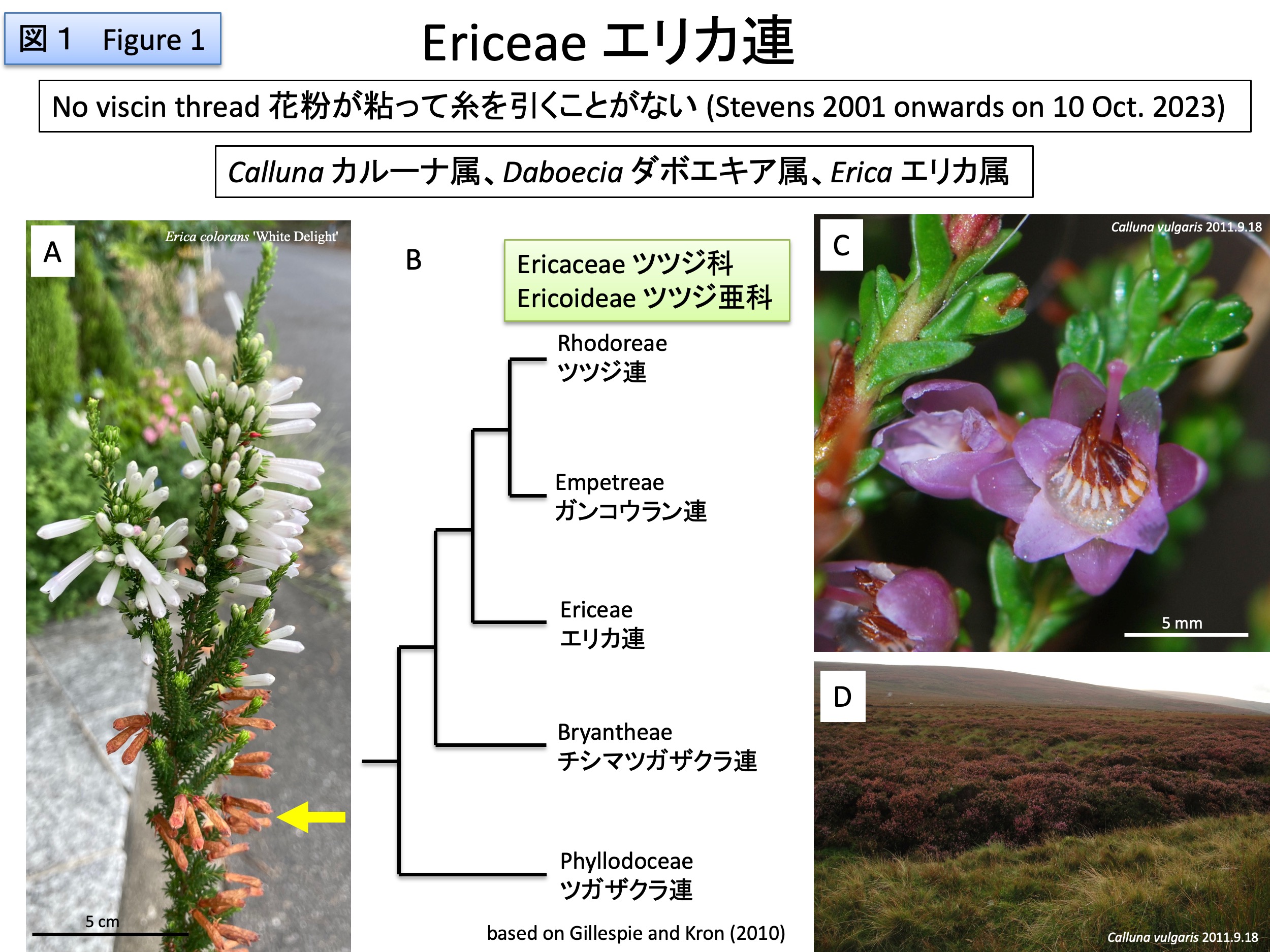
同僚の先生から、「研究所の隣のホテルの前で咲いている、シソのような花を付けた裸子植物(A)はなんですか」と聞かれた。さっそく見に行くと、エリカ コロランスErica coloransのホワイトデライト“White Delight”という品種だった。エリカ コロランスは、シソ科や裸子植物とは縁遠く、ツツジ科ツツジ亜科エリカ連に属する(B: Gillespie and Kron 2010)。エリカ連の種は、花粉が粘って糸を引くことがない形質が共通しており(Stevens 2001 onwards on 10 Oct. 2023)、カルーナ属 Calluna(C、D)、ダボエキア属 Daboecia、エリカ属 Erica (A)の3属からなる(Stevens et al. 2004)。エリカ連の種はイギリスなどのヒース heathの主要構成樹種である(D:イギリス、Yorkshire Dales国立公園のマラム・コーヴ Malham Coveに群生するCalluna vulgaris)。
I was asked by a colleague about a gymnosperm. with flowers resembling those of the mint family (Lamiaceae) (A) , which was blooming in front of the hotel next to our research institute. I went to see it immediately and found out it was Erica colorans “White Delight.” Erica colorans is distant from the Lamiaceae or gymnosperms, and it belongs to the tribe Ericeae, the subfamily Ericoideae of the heath family Ericaceae (B: Gillespie and Kron 2010). Species within Ericeae share a common characteristic of not producing sticky and thread-drawing pollen (Stevens 2001 onwards on 10 Oct. 2023). This subfamily comprises three genera: Calluna (C, D), Daboecia, and Erica (A) (Stevens et al. 2004). Species within Ericeae are the main components of heath ecosystems in countries like the UK (D: Calluna vulgaris forming extensive colonies at Malham Cove in the Yorkshire Dales National Park in the UK).
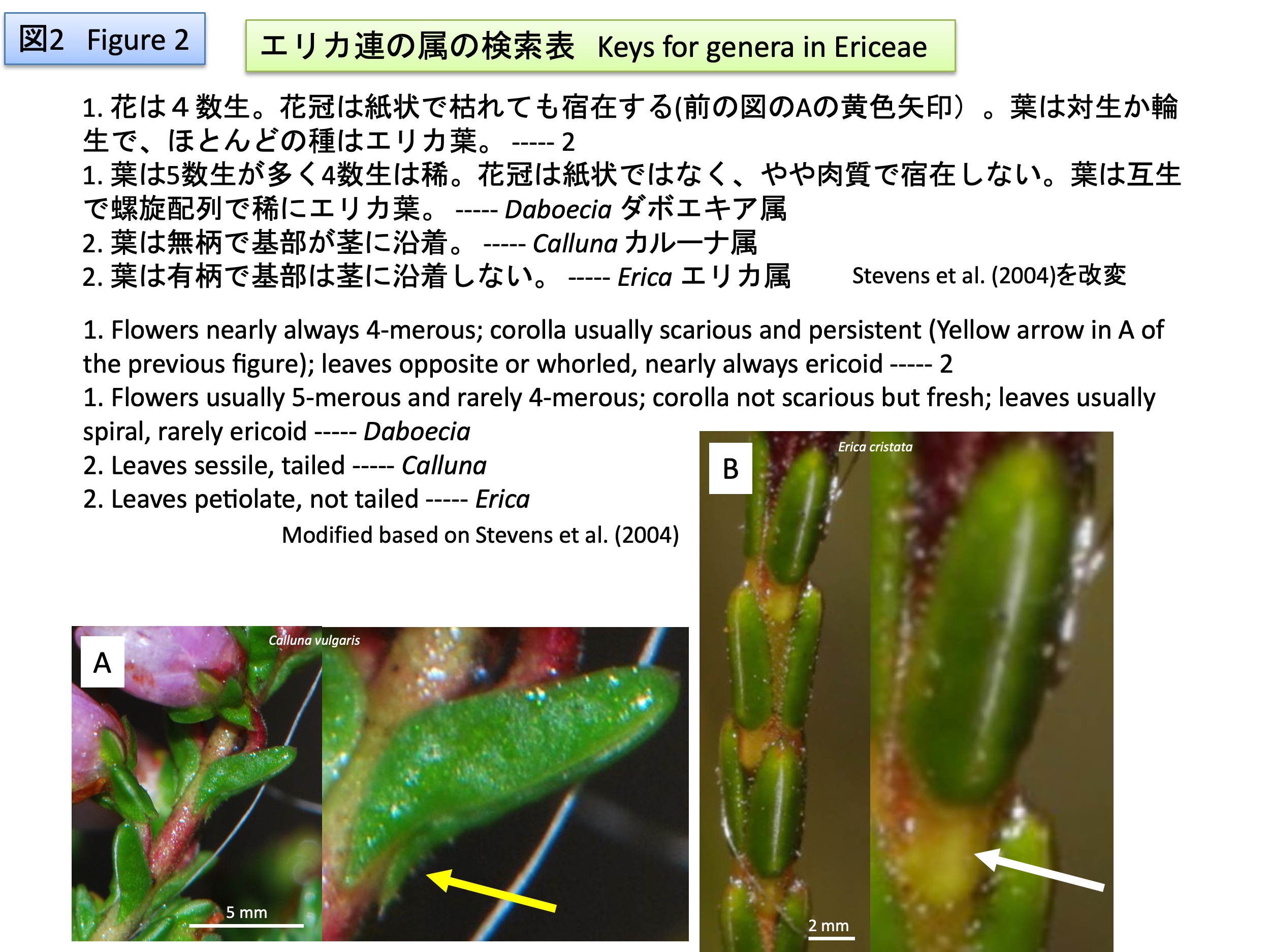
エリカ連の3属は、花の数生、花冠が宿在するか、葉序、葉の基部が茎に沿着するかどうか(AのCalluna vulgarisの葉の基部は、黄色矢印部分で沿着しており、BのErica cristataは葉柄[白色矢印]が明確で葉身基部は沿着していない)、エリカ葉を形成するかで分類できる(Stevens et al. 2004)。
The three genera of Ericeae can be classified by the number of flowers, whether the corolla is scarious and persistent, the phyllotaxy, whether the leaves are petiolate or tailed (A, Calluna vulgaris: the sessile leaves are tailed along the stem at the yellow arrowhead; B, Erica cristata: the petiole [white arrow] is prominent and the leaf base is not tailed), and whether they form ericoid leaves (Stevens et al. 2004).
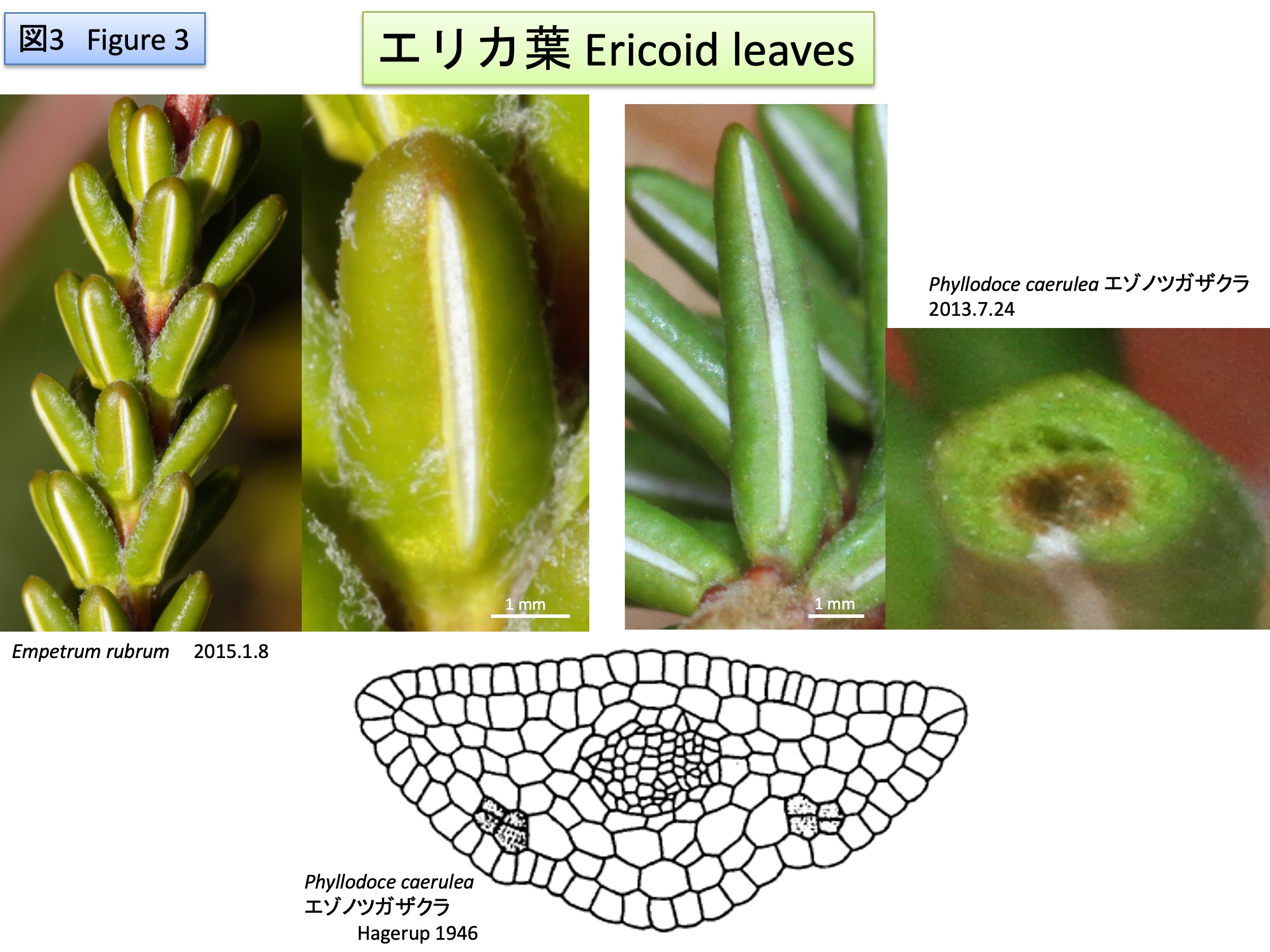
エリカ連のエリカ属やカルーナ属、ガンコウラン連、ツガザクラ連の葉は裏に伸び、伸びた部分が曲がって裏側表面を被う。これらの種は強風の吹くところに自生しているので、葉の裏側表面にある気孔周辺の湿度を上げている点で適応的だと考えられている(Bocher 1981)。一件すると葉の辺縁が背軸側に曲がって伸びているようだがそうではない。葉の背軸側に新規に分裂組織が形成され、葉の裏側からあらたに突起が生じ、それがもともとの葉縁と調和的に成長する。もともとの分裂組織に新たな分裂組織が加わってできる葉なので、重複葉身duplicate leaf bladeと呼ばれる。Hagerup (1946)のエゾノツガザクラの葉の断面図で、背側の黒点のある細胞が新たに分裂を開始する細胞である。
Species in Erica、Empetrum and Phyllodoce form leaves with enation. Protruded parts curved to the abaxial side to cover abaxial surface. These species are distributed in the area with strong wind and the morphology is beneficial to survive in the environment to keep moisture to the abaxial surface with stomata (Bocher 1981). Meristematic activity is changed from original leaf margins to abaxial regions shown in dots (Hagerup 1946).
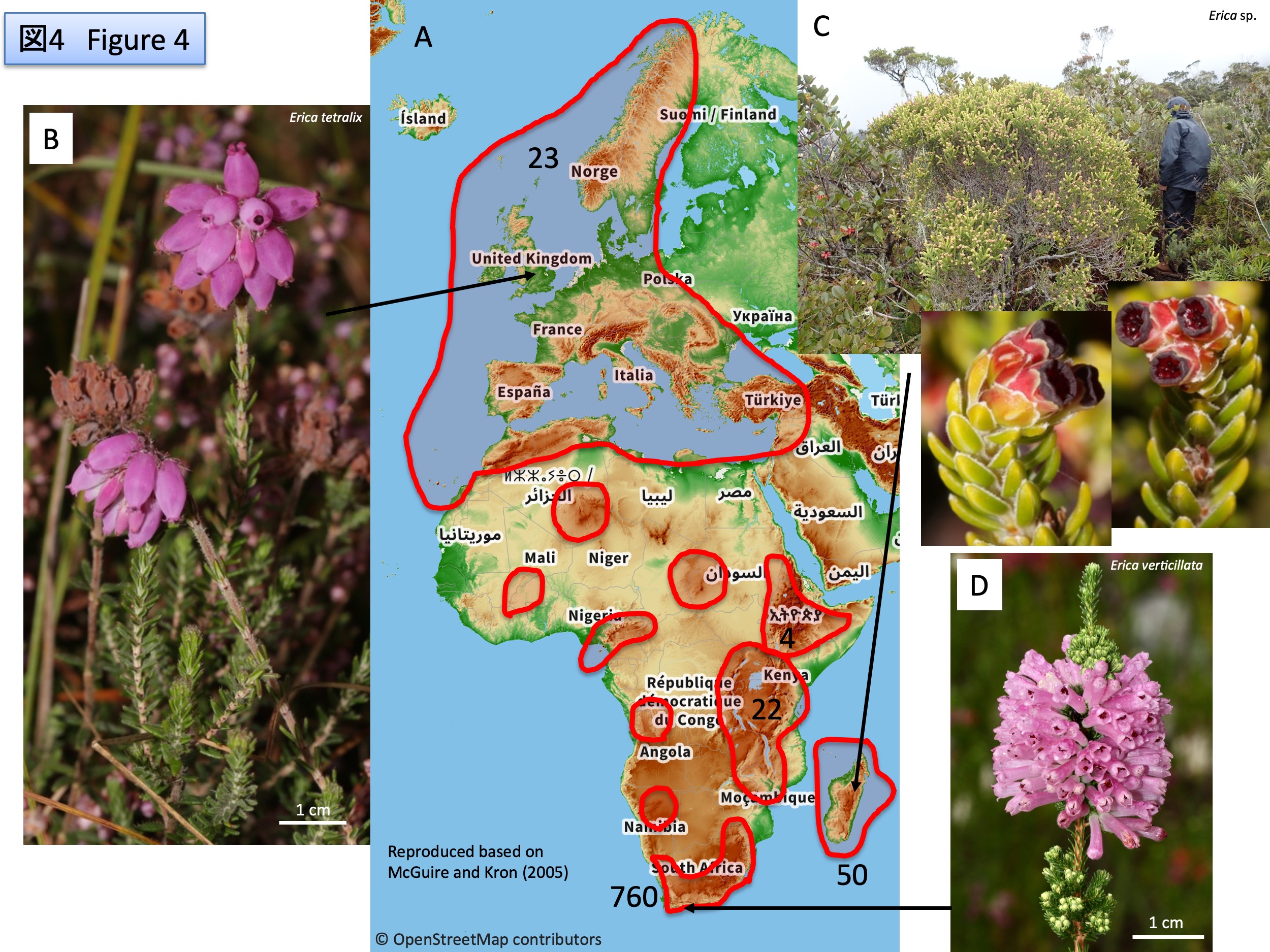
エリカ属 Ericaは、約865種からなり、北欧から、アフリカの熱帯地方の高山を経て、マダガスカル、南アフリカまで、南北に分布する(McGuire and Kron 2005)。南アフリカでは約760種に適応放散している。分布図(A)は、McGuire and Kron (2005)を改図し、種数の多い分布域に数字で種数を示した。(B)はイギリスのヨークシャー地方に自生するErica tetralix、(C)はマダガスカルのMarojeji山に自生し風媒花の種、(D)は南アフリカに自生するErica verticellata。
The genus Erica consists of ca. 865 species and has a north-south distribution from northern Europe, through the high mountains of tropical Africa, to Madagascar and South Africa (McGuire and Kron 2005). In South Africa, Erica has adapted and dispersed to about 760 species. Distribution map (A) is modified from McGuire and Kron (2005), with the number of species indicated by numbers in the distribution areas with the relatively higher number of species. (B) is Erica tetralix, native to Yorkshire, England; (C) is a wind-pollinated species native to Mount Marojeji, Madagascar; (D) is Erica verticellata, native to South Africa.
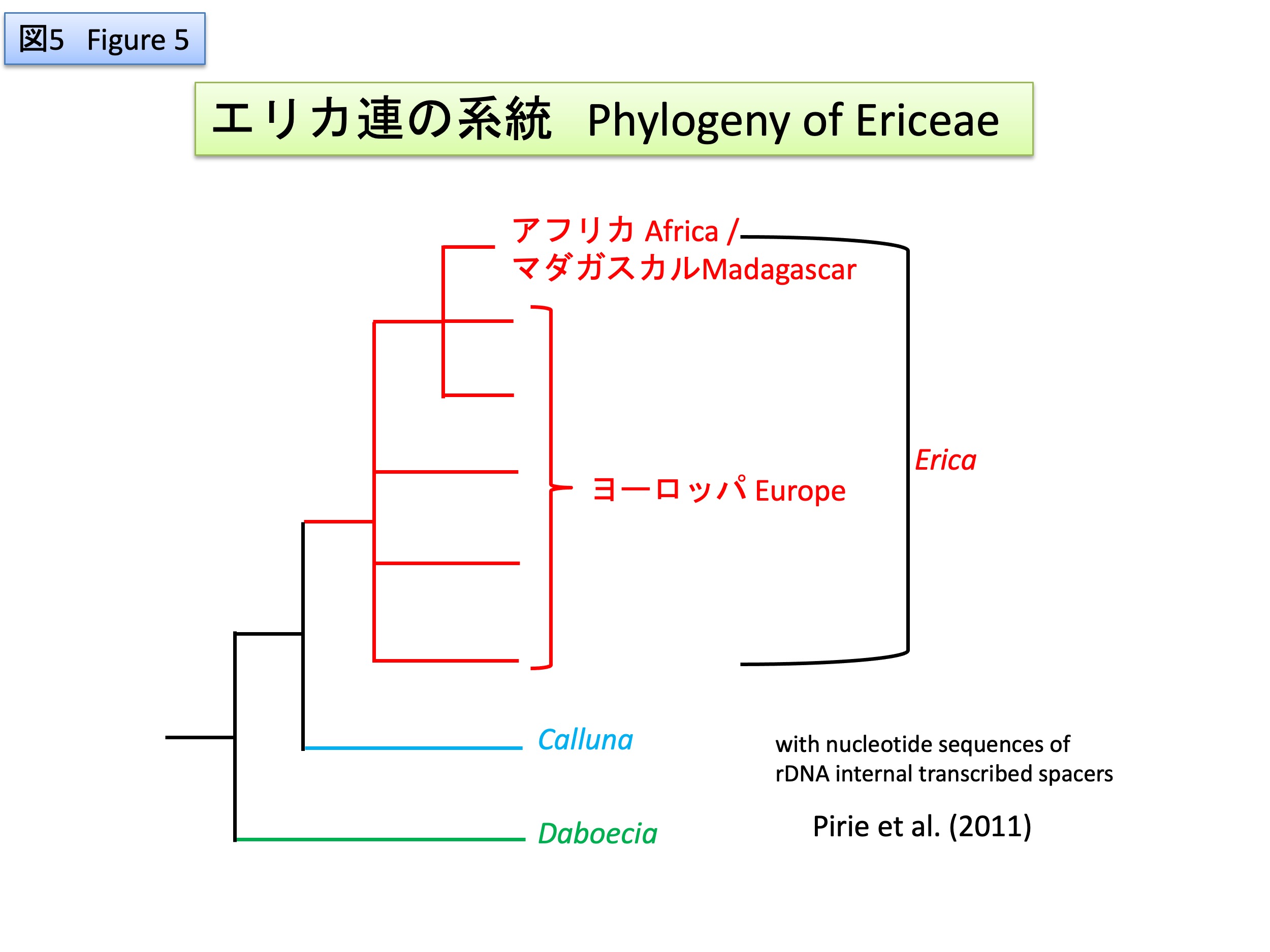
葉緑体DNAや核のrDNAの遺伝子間領域の塩基配列比較から、エリカ連の中で、デボエキア属が最初に分岐し、その後、カルーナ属とエリカ属が分岐したと推定されている(McGuire and Kron 2005, Pirie et al. 2011)。エリカ属の中では、ヨーロッパに分布する種が基部で側系統となり、アフリカとマダガスカルに分布する種類は系統樹の末端で単系統群となることから、エリカ属の共通祖先はヨーロッパに起源したと推定されている(McGuire and Kron 2005, Pirie et al. 2011)。また、西ヨーロッパの5600万年前の地層からエリカ属の花粉が産出する(Hofmann 2018)ことから、大陸移動により、チーシス海が閉じ、ヨーロッパとアフリカに陸橋のできた新生代中新世中期(約1700万年前)(Levyns 1964)にヨーロッパからアフリカへ分布を広げたのではないかと推定されている(McGuire and Kron 2005)。
Based on sequence comparisons of chloroplast genes and intergenic regions of nuclear rDNA, it has been inferred that the genus Deboecia was the first to diverge within the tribe Ericeae, followed by Caruna and Erica (McGuire and Kron 2005, Pirie et al. 2011). Within the genus Erica, the common ancestor of Erica is presumed to have originated in Europe, as the species distributed in Europe are lateral at the base, while the species distributed in Africa and Madagascar form a monophyletic group at the terminal of the phylogenetic tree (McGuire and Kron 2005, Pirie et al. 2011). In addition, fossil pollen of Erica was found from 56 Ma (million years ago) -old strata in Western Europe (Hofmann 2018), suggesting that the genus have spread from Europe to Africa during the middle Cenozoic Miocene (about 17 Ma) (McGuire and Kron 2005), when continental drift closed the Tyasis Sea and created a land bridge between Europe and Africa (Levyns 1964).
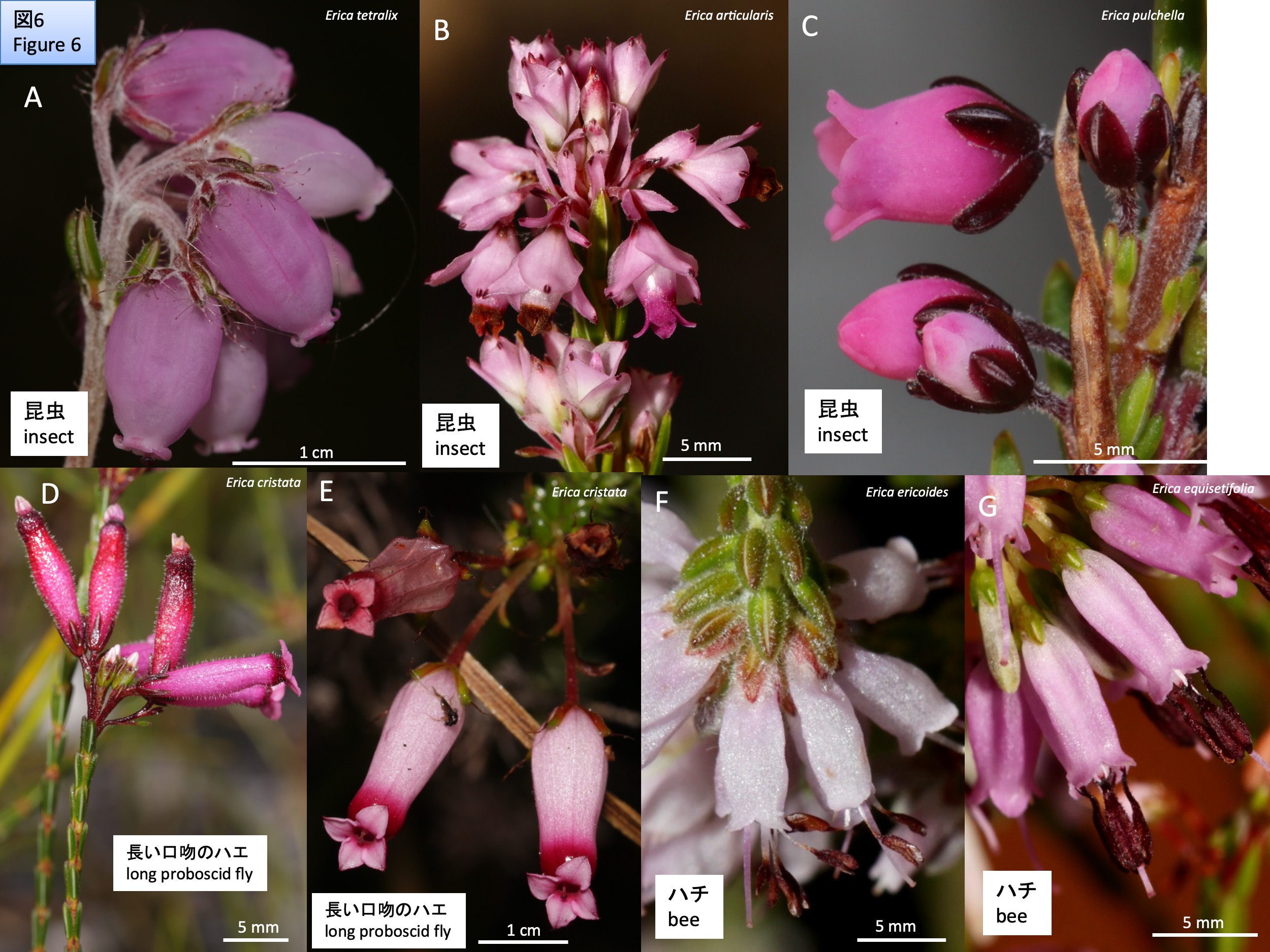
ヨーロッパの種は釣り鐘型の花(A)を形成し、虫媒の可能性が高いと考えられており(McGuire and Kron 2005)、アザミウマが主たる媒介昆虫ではないかと推定されている(Hagerup and Hagerup 1953)。一方、南アフリカでは花形態が多様化し、長い筒状から短い壺型までさまざまな形態の花を持つ種が進化している。この多様性は、花粉送粉動物との共進化によってもたらされた可能性が高い。昆虫媒だけでも、壺形(B)や球形(C)でアザミウマなどによって花粉媒介される種に加え、花冠が筒状に伸びて(D、E)花冠よりやや長い口吻を持つハエによって媒介される種、雄ずいが花冠先端から突出し(F、G)ハチによって媒介される種などが見られる(Rebelo et al. 1985, Oliver 1991, Pirie et al. 2011)。(A) イギリスヨークシャー地方で撮影したErica tetralix、(B) Erica articularis、(C) Erica pulchella、(D) Erica cristata、(E) Erica cristata、(F) Erica ericoides、(G) Erica equisetifolia。(B)から(G)は南アフリカのFernkloof Nature Reserveにて撮影。
European species form bell-shaped flowers (A) and are likely pollinated by insects (McGuire and Kron 2005), with thrips presumed to be the primary vector (Hagerup and Hagerup 1953). On the other hand, floral morphology has diversified in South Africa, with species having evolved a variety of flower morphologies ranging from long tubular to short vase-shaped. This morphological diversity should have coevolved with pollinators: flowers with urn-shaped (B) or spherical (C) corollas are pollinated by thrips; tubular corollas (D, E) are by flies with slightly longer proboscises than corollas; flowers with protruding stamens are by by bees(F、G) (Rebelo et al. 1985, Oliver 1991, Pirie et al. 2011). (A) Erica tetralix native to Yorkshire, England, (B) Erica articularis, (C) Erica pulchella, (D) Erica cristata, (E) Erica cristata, (F) Erica ericoides, (G) Erica equisetifolia. (B) to (G) were taken at Fernkloof Nature Reserve, South Africa.
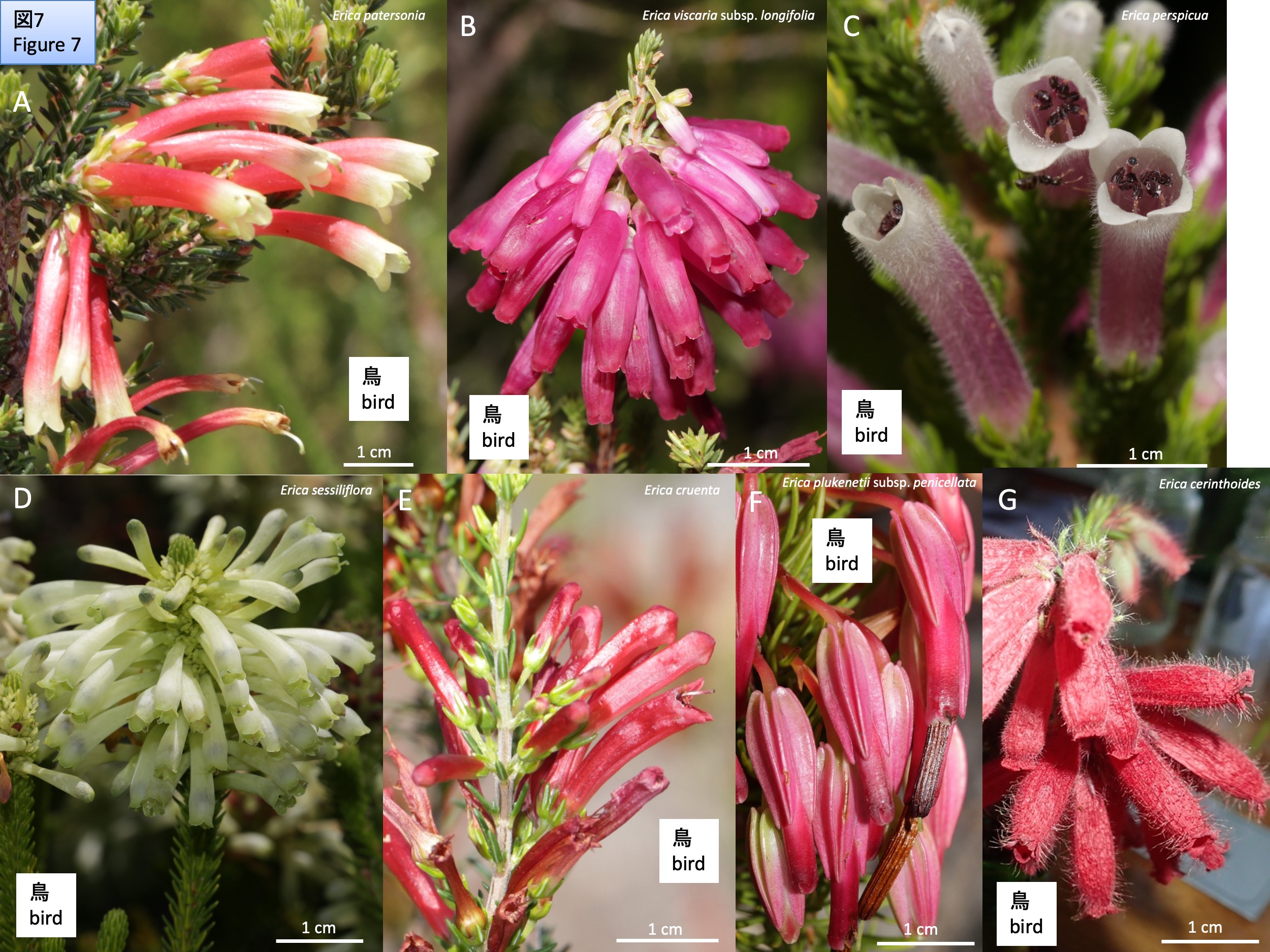
昆虫媒花よりも花冠が伸び、頑丈になった鳥媒花の種も多く見られる。図1AのErica coloransや図2DのErica verticillataに加え、 Erica patersonia (A)、Erica viscaria subsp. longifolia (B)、Erica perspicua (C)、Erica sessiliflora (D)、Erica cruenta (E)、Erica plukenetii subsp. penicellata (F)、Erica cerinthoides (G)など少なくとも約70種が鳥媒だと考えられている(Rebelo et al. 1985)。ズズメ目タイヨウチョウ科のオナガゴシキタイヨウチョウNectarinia violaceaが主たる媒介鳥だと考えられている(Rebelo et al. 1985, Oliver 1991)。
There are also a number of bird pollinated species with more elongated and robust corollas than insect pollinated species. In addition to Erica colorans (Figure 1A) and Erica verticillata (Figure 2D), Erica patersonia (A), Erica viscaria subsp. longifolia (B), Erica perspicua (C), Erica sessiliflora (D), Erica cruenta (E), Erica plukenetii subsp. penicellata (F), Erica cerinthoides (G), and at least about 70 other species are considered to be bird pollinated (Rebelo et al. 1985). The sunbird Nectarinia violacea is thought to be the primary pollinator (Rebelo et al. 1985, Oliver 1991).
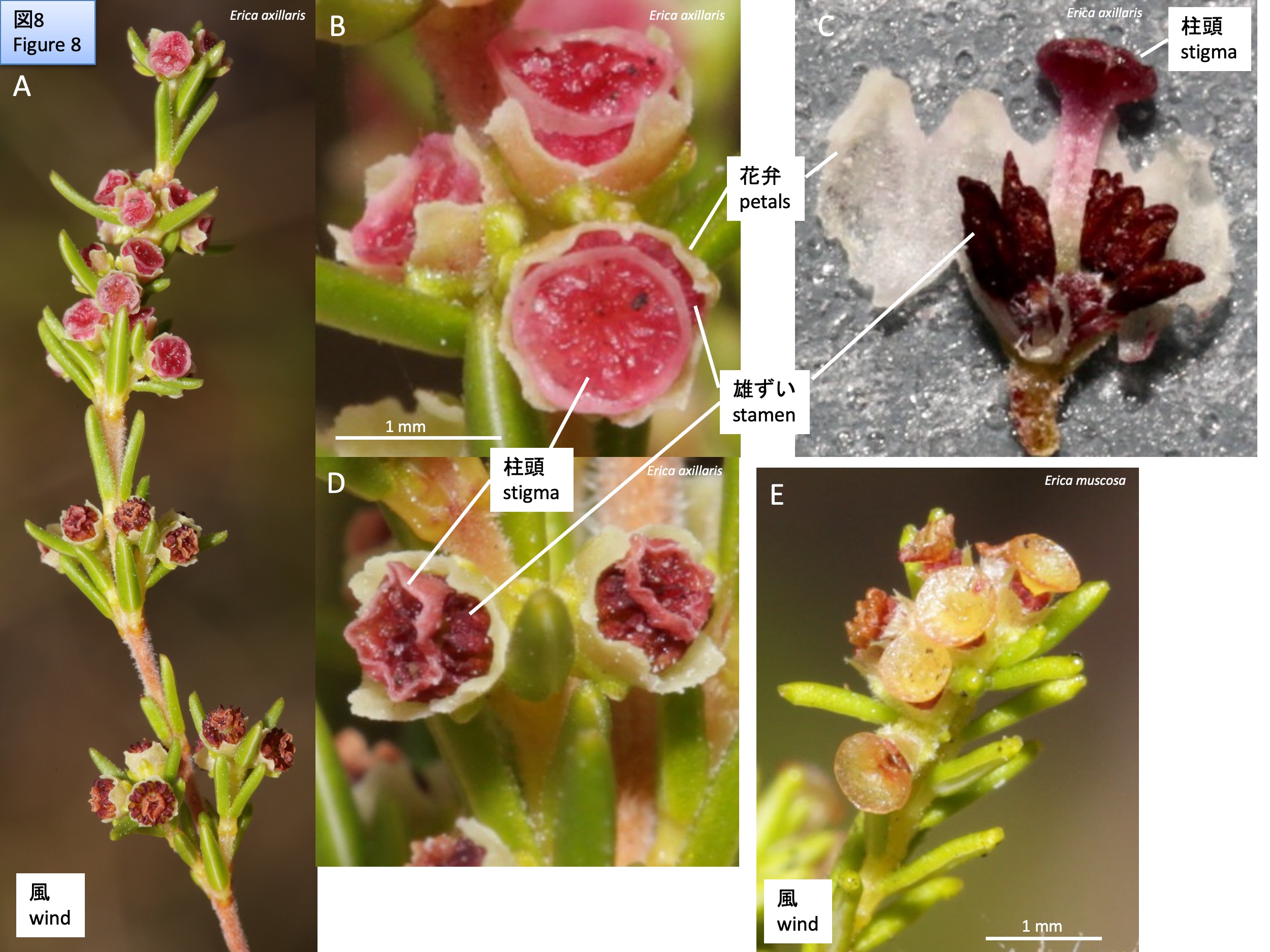
さらに、約20種は、風媒花へと進化している(AーE)。昆虫媒花や鳥媒花に比べ、花弁が縮小し、柱頭が肥大し突出する(B-D)。 (A-D) Erica axillaris、(E)Erica muscosaはFernkloof Nature Reserveで撮影。花形態は、花粉媒介動物ごとに、それぞれ似たような形に収斂進化することが知られており、ポリネーションシンドローム pollination syndromeと呼ばれる。南アフリカの系統ではアザミウマ媒花、長い口吻のハエ媒花、ハチ媒花、鳥媒花に加えて、風媒花が、何回も平行的に進化しており(Pirie et al. 2011)、形態形成遺伝子の研究が可能となれば、ポリネーションシンドロームの進化機構を解析する良い材料になりうると思われる。
In addition, about 20 species have evolved to form wind-pollinated flowers (A-E). Compared to insect- and bird-pollinated flowers, petals are reduced and the stigmas are enlarged and protruding (B-D). (A-D) Erica axillaris and (E) Erica muscosa were photographed at Fernkloof Nature Reserve, South Africa. Flower morphology is known to convergently evolve into similar forms for each pollinator, a phenomenon known as the pollination syndrome. In the South African lineage, flowers pollinated by thrips, long proboscis flies, bees, and birds as well as wind have evolved several times in parallel (Pirie et al. 2011), which may provide good material for analyzing the evolutionary mechanism of the pollination syndrome if genes regulating flower morphology can be studied.
References:
Bocher TW. 1981. Evolutionary trends in Ericalean leaf structure. Biol Skr kgl danske Vidensk Selsk 23: 1–64.
Gillespie, E. and Kron, K. 2010. Molecular phylogenetic relationships and a revised classification of the subfamily Ericoideae (Ericaceae). Mol. Phyl. Evol. 56: 343-354.
Hagerup O. 1946. Studies on the Empetraceae. Kgldanske Vidensk Selsk biol Medd 20: 1–49.
Hagerup, E. and Hagerup, O. 1953. Thrips pollination of Erica tetralix. New Phytol. 52: 1-7.
Hofmann, C.C. 2018. Light and scanning electron microscopic investigations of pollen of Ericales (Ericaceae, Sapotaceae, Ebenaceae, Styracaceae and Theaceae) from five lower and mid-Eocene localities. Bot. J. Linnean Soc. 187: 550-578.
Levyns, M.R. 1964. Migrations and origin of the Cape Flora. Trans. R. Soc. S. Afr. 37: 85-107.
McGuire, A.F. and Kron, K.A. 2005. Phylogenetic relationships of European and African Ericas. Int. J. Plant Sci. 166: 311-318.
Oliver, E.G.H. 1991. The Ericoideae (Ericaceae) – a review. Contrib. Bolus Herb. 13: 158-208.
Stevens, P.F. 2001 onwards. Angiosperm Phylogeny Website. 10th Oct. 2023, http://www.mobot.org/MOBOT/research/APweb/. Stevens, P.F. with Luteyn, J., Oliver, E.G.H., Bell, T.L., Brown, E.A., Crowden, R.K., George, A.S., Jordan, G.J., Ladd, P., Lemson, K., McLean, C.B., Menadue, Y., Pate, J.S., Stace, H.M., and Weiller, C.M. 2004 Ericaceae. pp. 145-194. In K. Kubitzki ed. The Families and Genera of Vascular Plants. VI.
